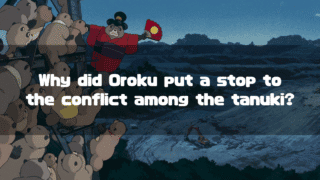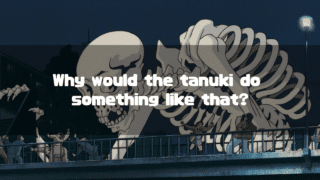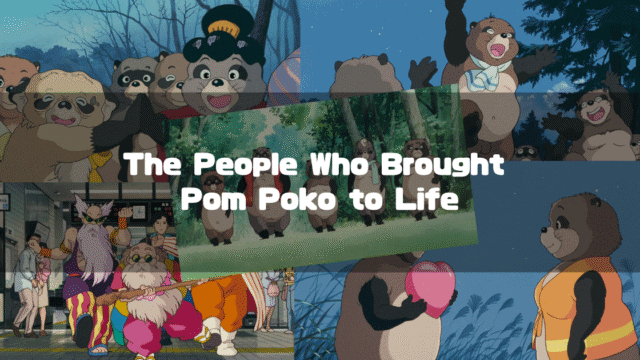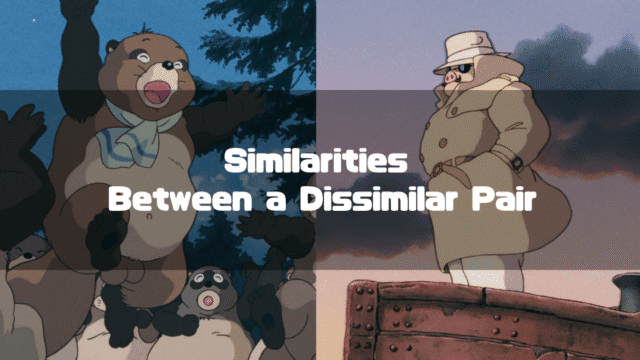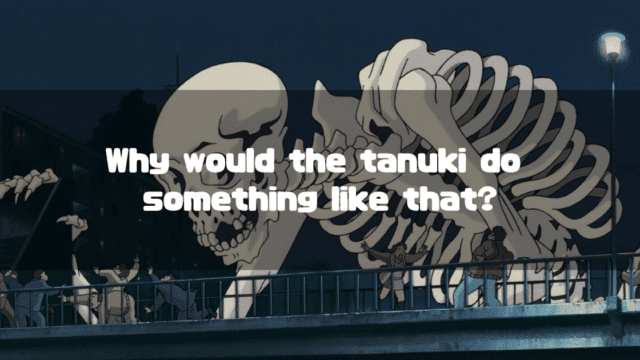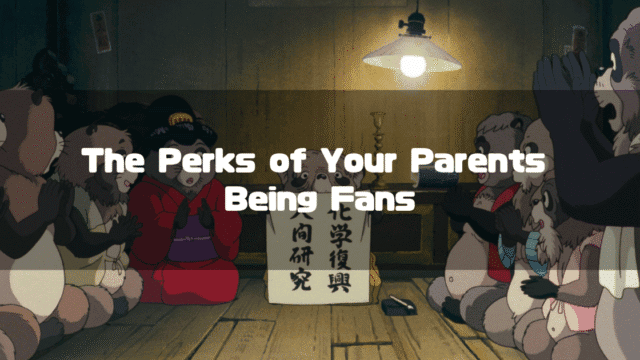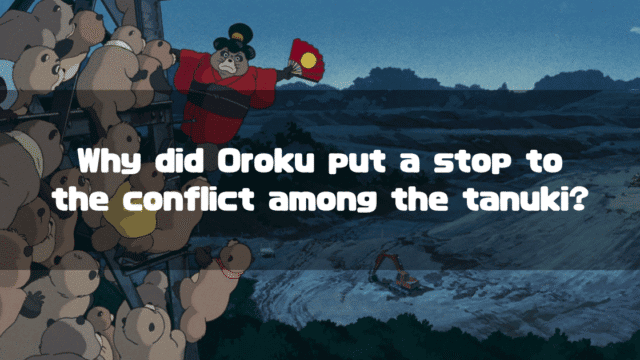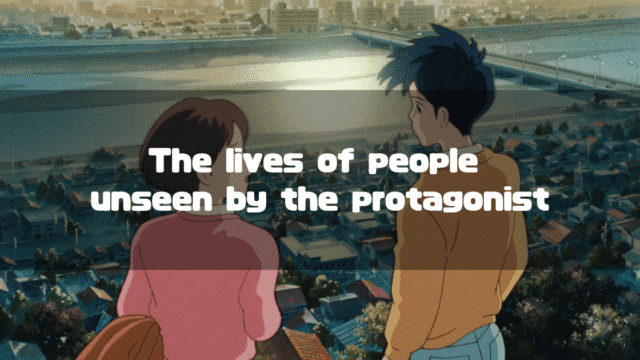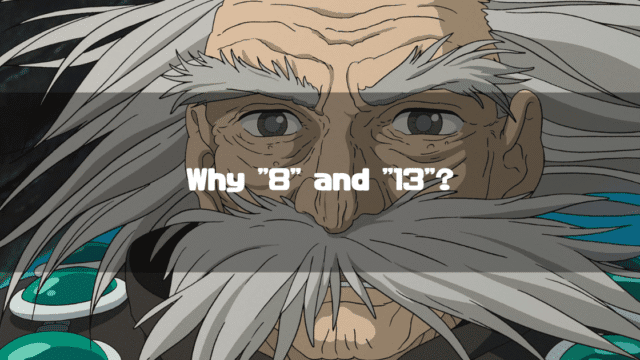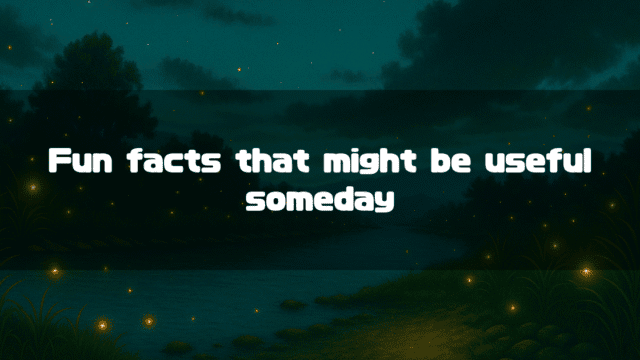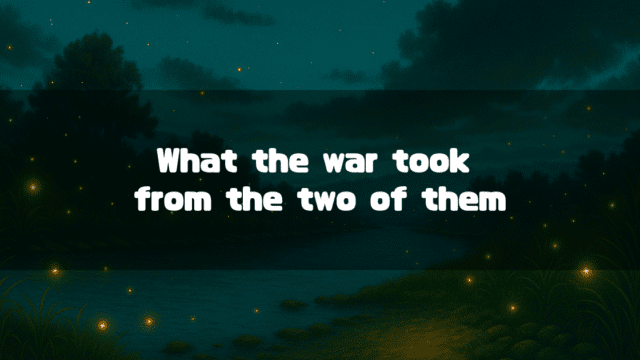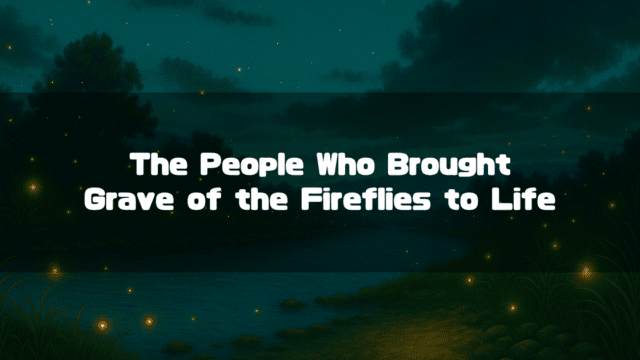I’ve previously written about Oroku’s Words and the Secret Art She Taught and Operation Specter, but this time, I want to write about what Pom Poko(Studio Ghibli Official) was about as a whole.
Thinking back, Pom Poko seems to be a film that “spoils itself with its title.” At least when combined with the movie theater trailers and TV commercials, it’s clear that it is a “story where the tanuki lose.” I was in the lower grades of elementary school when it was released, and luckily my parents took me to see it in a theater, but it seems a bit strange to go out of your way to see a “story where the tanuki lose.”
Nevertheless, Pom Poko is still worth watching. First, let’s think about “defeat” while looking back at the battles of the tanuki depicted in the main story.
*This article is an English translation of the original Japanese article, 「平成狸合戦ぽんぽこ」の面白さ③【敗北の物語と「どっこい生きる」ということ】.
An AI explains the content of this article in an easy-to-understand conversational (radio-style) format.
- Depicting the Process of Defeat in Stages
Pom Poko realistically portrays the “steps of defeat,” from the tanuki’s “phantom victory” to “frenzy,” “a desperate dream,” and “kamikaze attacks, suicide, and transformation,” drawing parallels with events like war. - A Device for Showing the Tanuki and Storyteller’s “Futile Efforts”
The comical tanuki and the humor of the narration elevate the story, allowing us to watch the serious “tragedy of futile efforts,” skillfully depicting a theme that director Isao Takahata would find difficult to portray with human characters. - An Abstracted “Structure of Defeat”
While reminiscent of the Pacific War, it depicts a more universal “emptiness and seriousness of a losing battle,” presenting the perspective that the essence of failure is to engage in a battle that is lost from the start. - The Preciousness of “Somehow, We Go On Living”
Director Takahata’s gentle yet stern message—that it is after defeat that one should stop the futile efforts and choose to “still go on living”—is encapsulated in the final phrase, “somehow, we’re still alive.”
The Steps of “Defeat” Depicted in Pom Poko
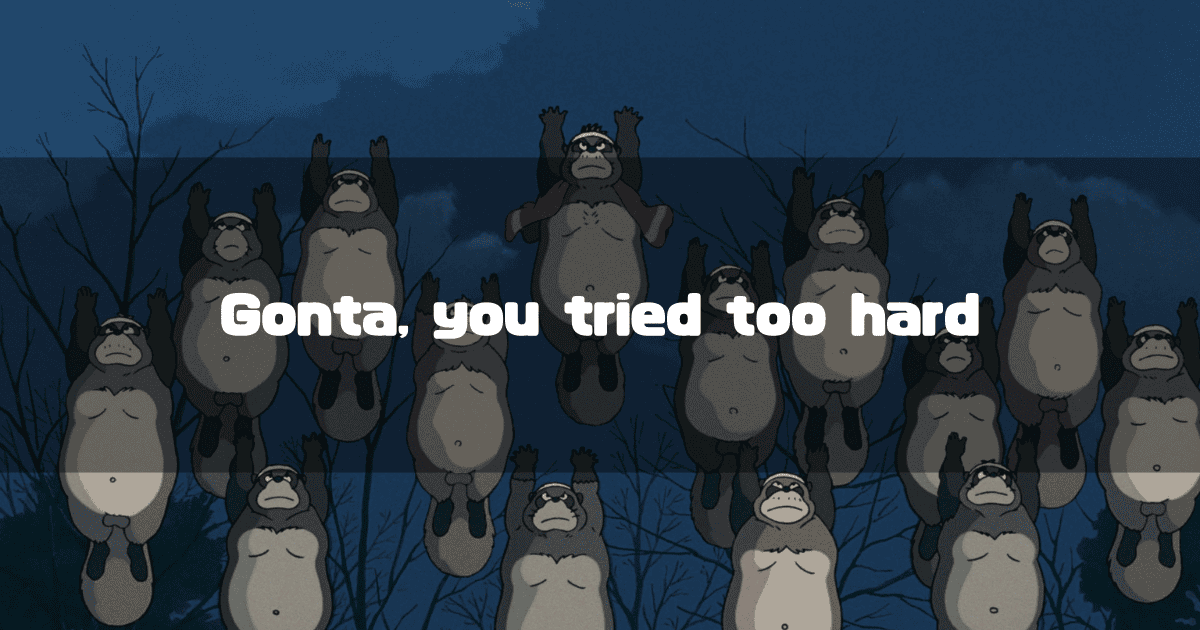
Gonta’s only effective strategy [Phantom Victory].
Anyone who has seen Pom Poko has probably thought, “Gonta’s first plan was the most effective one, wasn’t it?” The only time in the film that humans were harmed was during the first operation carried out by Gonta’s faction. This incident led to critical media coverage of the Tama New Town development, and the tanuki were greatly encouraged. Not only that, they were so overjoyed that they held a huge banquet that very day.
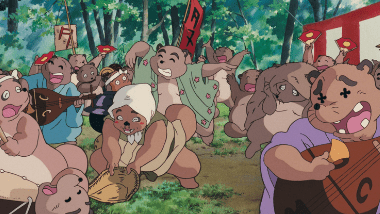
However, this was also the first step toward “defeat.” If Gonta’s plan had failed, the tanuki might have become disheartened, and the subsequent events might not have happened. In a sense, it could be said to have accelerated the virtual extinction of the Tama tanuki. And another important point is that while it did inflict damage on humans, it had absolutely no effect on changing the situation. In fact, the development of New Town was steadily progressing. In other words, their victory was a phantom.
This is the first step of defeat depicted in Pom Poko: the “phantom victory.”
The Tanuki Who Trick People and Operation Twin Stars [The Frenzied Masses]
As it turned out, the success of Gonta’s operation emboldened the tanuki, causing them to focus their efforts on tricking humans. This alone is hard to watch, but even the usually sensible Shoukichi carries out “Operation Twin Stars” due to his affection for Okiyo.

This operation, too, was ultimately just a trick on people and served no real purpose (though, I can understand Shoukichi’s feelings, so I can’t really blame him). Only Gonta felt frustrated, but the frenzied tanuki couldn’t stop themselves. In Gonta’s eyes, they must not have looked like warriors fighting a war against humans. They were surely just a mob, reveling in the success of his own plan.
This is the second step toward defeat, “the frenzied masses.”
The Tanuki Who Dream of Operation Specter [A Desperate Dream]
Even the tanuki in their frenzy eventually realize, “This can’t go on!” but at that point, their saviors arrive. The elders from Shikoku, of course.
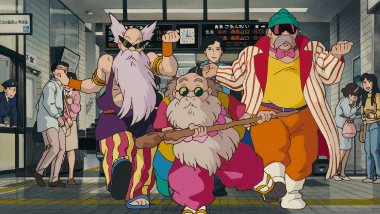
It’s hard to believe that the tanuki who entrusted their fate to these elders, who arrived in such bizarre attire after declaring their intention to “go to Tama,” were capable of sound judgment. In the end, they placed their faint hopes on Operation Specter, which required a great deal of effort for no gain. Watching from the outside, it’s clear that the tanuki had realized that they could no longer change the situation with the means available to them—”tricking people.” That is why they had become so desperate.
This is the third step toward defeat, “a desperate dream.”
The Decisive Defeat [Kamikaze Attack, Suicide, and the Final Transformation]
The tanuki, who had pinned their desperate dreams on Operation Specter, split into roughly three factions upon learning of its failure. One was the hardline faction led by Gonta, another was the escapist faction led by Yashimano Hage, and the last was the exposure faction.
In the end, the hardliners lost their lives at the hands of humans,
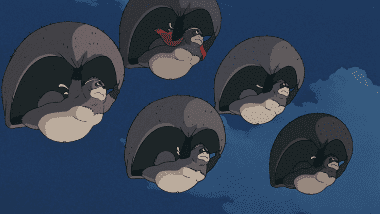
and the escapists committed mass suicide by riding a treasure ship.
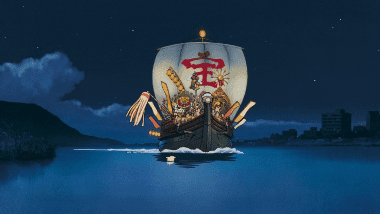
In any case, they had fundamentally lost faith in a future where they could survive, and as a result, they chose a shortsighted path. The exposure faction, on the other hand, revealed to the public that they had carried out Operation Specter,

and ultimately decided to live on in the form of the humans they had been fighting (the final transformation).
Thus, the tanuki who were defeated by humans had no choice but to die or assimilate with the enemy. Thinking back, it all started with Gonta’s faction’s plan. Shoukichi went along with it, but somehow, it feels like Gonta tried too hard. Right to the very end.
Well, thinking about Gonta makes me feel rather sad, but in this context, what can we ultimately say Pom Poko was about?
What Was Pom Poko Ultimately About?
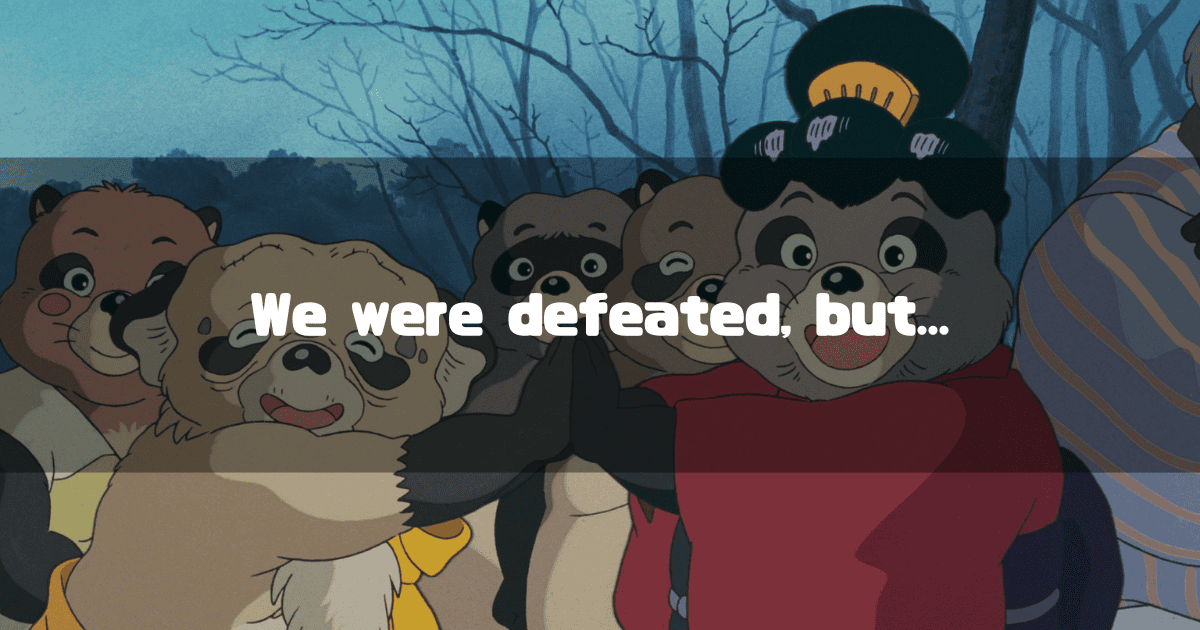
The Abstract Structure of “Defeat”
Looking at the steps of defeat described above, what we inevitably recall is the “defeat in the Pacific War.” The “phantom victory” is the “attack on Pearl Harbor,” our common people were also heading to war at the time, and the construction of the battleship Yamato was a desperate dream. And at the very end, we resorted to a strategy that could hardly be called a strategy—the kamikaze attack—and we decided to live “like Americans” (how comical, and in the end, not even “like Americans”).
However, I doubt that director Takahata wanted to do something so specific. I believe he must have been trying to do something more abstract. To put it in a nutshell, not limited to the Pacific War,
it seems to me that what was depicted was that in the end, we are defeated not because we did something, nor because we didn’t do something, but because we fight a losing battle from the start.
And the important thing is that even if it is a losing battle, we who are in the midst of it are always taking things very seriously, and at the same time, watching it from the sidelines must seem like a futile effort.
However, if that structure of futile effort were depicted using humans, we would probably have ended up watching a work like Grave of the Fireflies again. The motif doesn’t need to be war; no one can bear to watch “a person who gets carried away by a small success, takes on a losing battle, and continues to make futile efforts in all seriousness, only to be defeated in the end.”
This “rawness of defeat” is likely the reason why this work was depicted as a “story of tanuki” and why rakugo storytellers were cast as voice actors. In other words, by turning the “futile effort” into a “comical story,” it became a “watchable story.” In the end, it probably boils down to the words “tragedy is comedy” and “comedy is tragedy.”
However, while it certainly depicts “defeat” abstractly, it doesn’t end with “defeat is comical~.” It also properly depicts what comes after defeat.
Still, Somehow, Let’s Go On Living.
Of course, the “Pom Poko-esque answer” to what comes after defeat is to “Somehow, we go on living.” We who are in the midst of “defeat” cannot stop our futile efforts even after being defeated. As a result, we may reach shortsighted conclusions like Gonta and Yashimano Hage.
However, wasn’t Director Takahata’s message, “It is precisely when we are defeated that we should stop the futile efforts and choose to ‘still go on living’!“? And that sentiment was likely condensed into the words “Somehow, we go on living.” If you die, it’s all over.
The final message may be a simple one. But it is surely Director Takahata’s great skill to have magnificently turned the poignant story of “a tale of defeat” into a “comical story” by using the stagecraft of “tanuki and storytellers.” For me, Pom Poko will always remain a masterpiece, and I might have new thoughts about it as I get older. The articles I wrote leading up to this one, Memories of Pom Poko, Oroku’s Words and the Secret Art She Taught and Operation Specter, are a summary of what I have thought about over a long period of time.
Until I make a new discovery, I’ll somehow go on living.
The images used in this article are from “Still Images from Studio Ghibli Works“.
About the Author
Recent Posts
- 2025-10-15
Indiana Jones and the Dial of Destiny(2023):Historical Background-WWII, the Real Dr. Schmidt, the Siege of Syracuse, and the Antikythera Mechanism - 2025-10-08
Why Does Children Who Chase Lost Voices Feel So Ghibli-esque? [Makoto Shinkai’s “Tale of Farewell”] - 2025-10-07
5 Centimeters per Second: Characters, Voice Actors, Character Analysis and Character Map - 2025-10-06
5 Centimeters per Second: Full Synopsis, Analysis, Ending Explained & Character Map (Spoilers) - 2025-10-04
5 Centimeters per Second Is Neither Depressing Nor Terrible: A Positive Interpretation of the Film


